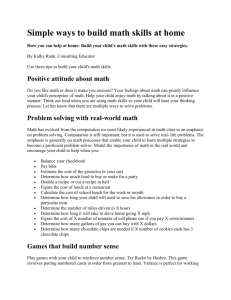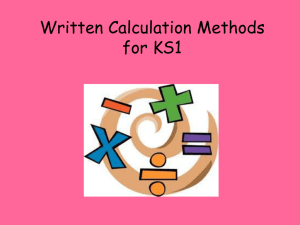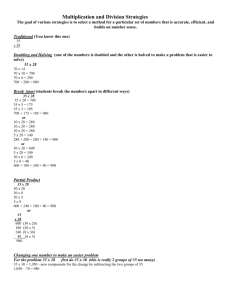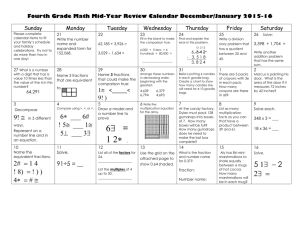Math
advertisement
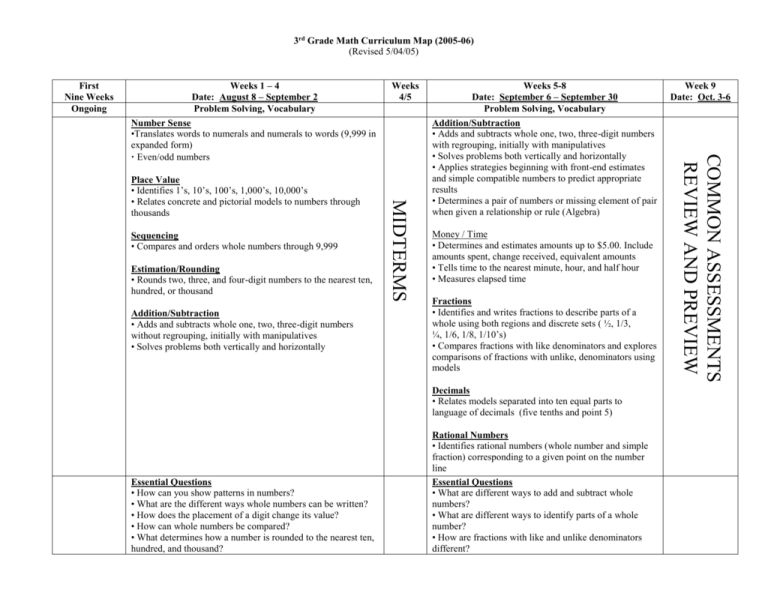
3rd Grade Math Curriculum Map (2005-06) (Revised 5/04/05) First Nine Weeks Ongoing Weeks 1 – 4 Date: August 8 – September 2 Problem Solving, Vocabulary Weeks 4/5 Sequencing • Compares and orders whole numbers through 9,999 Estimation/Rounding • Rounds two, three, and four-digit numbers to the nearest ten, hundred, or thousand Addition/Subtraction • Adds and subtracts whole one, two, three-digit numbers without regrouping, initially with manipulatives • Solves problems both vertically and horizontally MIDTERMS Place Value • Identifies 1’s, 10’s, 100’s, 1,000’s, 10,000’s • Relates concrete and pictorial models to numbers through thousands Addition/Subtraction • Adds and subtracts whole one, two, three-digit numbers with regrouping, initially with manipulatives • Solves problems both vertically and horizontally • Applies strategies beginning with front-end estimates and simple compatible numbers to predict appropriate results • Determines a pair of numbers or missing element of pair when given a relationship or rule (Algebra) Money / Time • Determines and estimates amounts up to $5.00. Include amounts spent, change received, equivalent amounts • Tells time to the nearest minute, hour, and half hour • Measures elapsed time Fractions • Identifies and writes fractions to describe parts of a whole using both regions and discrete sets ( ½, 1/3, ¼, 1/6, 1/8, 1/10’s) • Compares fractions with like denominators and explores comparisons of fractions with unlike, denominators using models Decimals • Relates models separated into ten equal parts to language of decimals (five tenths and point 5) Essential Questions • How can you show patterns in numbers? • What are the different ways whole numbers can be written? • How does the placement of a digit change its value? • How can whole numbers be compared? • What determines how a number is rounded to the nearest ten, hundred, and thousand? Rational Numbers • Identifies rational numbers (whole number and simple fraction) corresponding to a given point on the number line Essential Questions • What are different ways to add and subtract whole numbers? • What are different ways to identify parts of a whole number? • How are fractions with like and unlike denominators different? Week 9 Date: Oct. 3-6 COMMON ASSESSMENTS REVIEW AND PREVIEW Number Sense •Translates words to numerals and numerals to words (9,999 in expanded form) • Even/odd numbers Weeks 5-8 Date: September 6 – September 30 Problem Solving, Vocabulary 3rd Grade Math Curriculum Map (2005-06) (Revised 5/04/05) • What are different ways to add/subtract numbers? 3rd Grade Math Curriculum Map (2005-06) (Revised 5/04/05) First Nine Weeks Vocabulary Weeks 1 – 4 Date: August 8 – September 2 Number Sense/Place Value Value Number line Even Odd Skip-count Digits Standard Expanded Word Benchmark Sequencing Greater Less Than Equal to Estimation/Rounding Rounding Estimate Addition/Subtraction Addend Total Sum Difference Number sentence Expression Operation Sign Every Day Counts Calendar Calendar: analyzing and predicting patterns; odd/even; multiples of 3 Weeks 5-8 Date: September 6 – September 30 Addition/Subtraction Addend Total Sum Difference Number sentence Expression Operation Sign Money/Time Change Amount Minute A.M. / P.M. Noon Midnight Elapsed time Schedule Calendar Quarter till Quarter past Fractions/Decimals/Whole Numbers Whole numbers Mixed numbers Denominator Numerator Halves Fourths Thirds Tenths Hundredths Decimal point Equivalent Calendar: analyzing and predicting patterns; odd/even; multiples of 3 Counting Tape: days in school number line; odd/even Counting Tape: days in school number line; odd/even Daily Depositor: place value; estimation 3rd Grade Math Curriculum Map (2005-06) (Revised 5/04/05) Daily Depositor: place value; estimation Computation: understanding number relationships; ‘doubles’ and ‘doubles plus one’ facts Computation: understanding number relationships; ‘doubles’ and ‘doubles plus one’ facts 3rd Grade Math Curriculum Map (2005-06) (Revised 5/04/05) Second Nine Weeks Ongoing Weeks 1 – 4 Date: October 11 – November 4 Weeks 5-8 Date: November 7 – December 9 Problem Solving, Vocabulary, Rounding Number Theory • Uses properties of addition and multiplication (including commutative, associative, property of zero and one) Division • Relates concrete/pictorial models to divide • Relates multiplication and division using fact families and models • Uses repeated subtraction to divide one and two digit numbers with and without remainder Essential Questions • How can you use models to divide two-digit by onedigit numbers? • How are multiplication and division related? • Why is it important to know your division facts? • What are the strategies you can use to learn your division facts? Week 9 Date: Dec. 12-16 COMMON ASSESSMENTS REVIEW AND PREVIEW Essential Questions • How can you use models to multiply two-digit by one-digit numbers? • Why is it important to know your multiplication facts? • What are the strategies you can use to learn your multiplication facts? MIDTERMS Problem Solving, Vocabulary, Rounding Multiplication • Realizes/understands importance of knowing basic multiplication facts • Immediately recalls multiplication facts zero through twelve • Multiplies whole numbers up to two-digit by one-digit numbers (Use models and make connections to computational strategies) • Relates concrete/pictorial models to multiply • Determines a pair of numbers or missing element of pair when given a relationship or rule (Algebra) • Writes a number sentence representing an array Weeks 4/5 3rd Grade Math Curriculum Map (2005-06) (Revised 5/04/05) Second Nine Weeks Vocabulary Every Day Counts Calendar Weeks 1 – 4 Date: October 11 – November 4 Multiplication Multiply Factors Product Sum Array Fact Number Theory Factors Product Sum Calendar: analyzing / predict patterns; multiples of 5 Calendar: analyzing and predicting patterns; multiples of 3 and 4; exploring two dimensional shapes Counting Tape: days in school; counting by 1, 5, and 10 Counting Tape: days in school; seeing 100 as sum of two addends Daily Depositor: place value to the hundreds; regrouping; mental math Computation: understanding number relationships; visualizing ‘ten plus’ facts Coin Counter: counting mixed coins; creating coin combinations for a given amount Weeks 5-8 Date: November 7 – December 9 Division Fact Dividend Quotient Divisor Remainder Daily Depositor: exploring place value to the thousands; writing larger numbers; expanded notation Computation: understanding number relationships; visualizing ‘9 plus’ facts; exploring multiplication as equal groups of objects Coin Counter: counting mixed coins; determining change from one dollar Clock: reading time to the nearest minute Clock: reading the hour hand; A.M. / P.M. Measurement: measuring distance in feet and yards; seeing equivalences Graph: collecting weather data at home and in another city; constructing and interoperating graphs 3rd Grade Math Curriculum Map (2005-06) (Revised 5/04/05) Third Nine Weeks Ongoing Weeks 1 – 4 Date: January 4 – January 27 Probability • Determines probability of a number given event through exploration of vocabulary: equally likely, least likely, most likely, possible, impossible Essential Questions • What are the steps involved in making and reading graphs? • How can you use appropriate instruments to measure different units? • What every day objects can you measure? • About how wide is your desk? About how much does your math book weigh? Week 9 Date: March 6-9 Sets • Identifies subsets of given sets • Uses these terms: all, some, none • Organizes elements of sets according to characteristics such as: shading, color, shape, size, design, use, number of sides Geometry/Patterns • Recognizes properties (sides/angles) of a triangle, circle, rectangle, square, closed and not closed figures • Recognizes and name solid figures – cylinders, cones, spheres, cubes; sort according to size and shape • Visualizes/draws, compares geometric shapes in various positions/orientations (flip, slide, turn) • Identifies geometric relations (parallel, inside, outside, same size and shape (shorter, larger, smaller, longer), Geometric transformations (same size/shape, different position, line of symmetry) • Identifies point, line, segment, ray, angles • Describes, extends, and makes generalizations about geometric and numeric patterns Essential Questions • How can you compare and contrast geometric shapes? • How does the changing of a position of a geometric shape change how it looks? • How can you use shape to discover the missing piece of a puzzle? COMMON ASSESSMENTS REVIEW AND PREVIEW Graphs • Organizes data into charts and tables and constructs bar graphs using scales of 1, 2, 5, and 10. Pictographs using scales of 1, 2, 3, 4, 5, or 10 units. • Collects, reads, interprets, and compares data in charts, tables, and graphs. Weeks 5-8 Date: January 30 – March 3 Problem Solving, Vocabulary, Rounding MIDTERMS Problem Solving, Vocabulary, Rounding Measurement - Metric • Uses appropriate instrument and unit (length, width, capacity, weight, mass, time and temperature) • Selects appropriate instruments and units (lengths, capacity, distance, height, etc.) • Measures using concrete materials, such as string, to find circumference, squares and tiles to find area (Perimeter equals adding sides, etc.) • Estimates or predicts measures of length, weight, volume, capacity and temperature. Weeks 4/5 3rd Grade Math Curriculum Map (2005-06) (Revised 5/04/05) Third Nine Weeks Vocabulary Weeks 1 – 4 Date: January 4 – January 27 Measurement - Metric Perimeter Area Length Width Distance Centimeter, Meter, Kilometer Capacity Volume Milliliter, Liter Weight Mass Gram, Kilogram Temperature Degree Celsius Graphs Grid Ordered Pair Data Every Day Counts Calendar Probability Likely (Least, Equally, More) All Some None Possible Impossible Calendar: creating daily number sentences (TE 49) Counting Tape: investigating rounding to the nearest ten; noting multiples of 3, 5, and 10; Weeks 5-8 Date: January 30 – March 3 Sets All Some None Geometry Side Angle (Right, Acute, Obtuse) Face Set Ray Line Line Segment Parallel Intersect Flip Slide Turn Closed Open Solid Plane Congruent Similar Horizontal Vertical Symmetrical Calendar: exploring multiples of 4; Counting Tape: noting multiples of 3,4,5 and 10 Daily Depositor: adding three numbers in sequence Daily Depositor: investigating a pairing strategy for adding numbers in a sequence Computation: writing number sentences and stories Computation: exploring multiples of 4 Coin Counter: counting by 25, 10, 5, and 1; determining fewest coins for a given amount Coin Counter: determining different coin combinations for $1; using an organized list 3rd Grade Math Curriculum Map (2005-06) (Revised 5/04/05) Measurement: capacity with cups and quarts; seeing equivalences 3rd Grade Math Curriculum Map (2005-06) (Revised 5/04/05) Fourth Nine Weeks Ongoing Weeks 1 – 4 Date: March 14 – April 13 Number Sentences • Selects appropriate symbol ( +, number sentence Essential Questions • How can you use appropriate instruments to measure different units? • What every day objects can you measure? • About how wide is your desk? About how much does your math book weigh? • How do you know which symbol to use in a number sentence? Weeks 5-8 Date: April 17 – May 12 Problem Solving, Vocabulary, Rounding MIDTERM QUIZ & END OF YEAR POST TEST Problem Solving, Vocabulary, Rounding Measurement - Customary • Uses appropriate instrument and unit (length, width, capacity, weight, mass, time and temperature) • Selects appropriate instruments and units (lengths, capacity, distance, height, etc.) • Measures using concrete materials such as string to find circumference, squares and tiles to find area (Perimeter equals adding sides, etc.) • Estimates or predicts measures of length, weight, volume, capacity and temperature. Weeks 4/5 CRCT – April 19-25 Review and enrich third grade skills as needed Preview fourth grade skills Week 9-10 Date: May 15-24 3rd Grade Math Curriculum Map (2005-06) (Revised 5/04/05) Fourth Nine Weeks Vocabulary Weeks 1 – 4 Date: March 14 – April 13 Measurement – Customary Perimeter Area Length Width Distance Inch, Foot, Yard, Mile Capacity Volume Cup, Pint, Quart, Gallon Weight Mass Ounce, Pound Temperature Degree Fahrenheit Weeks 5-8 Date: April 17 – May 12 Review third grade vocabulary and Preview fourth grade vocabulary Number Sentences Number sentence Expression Operation Sign Equivalent Every Day Counts Calendar Calendar: exploring fractions; half, third, fourth; whole numbers Calendar: symmetry / congruence; multiples of 3, 6 Counting Tape: problem solving Counting Tape: noting multiples of 3,4,5,6, and 10 Daily Depositor: rounding to nearest hundreds Daily Depositor: strategies for arriving at the sum; mental math and estimation Computation: exploring the concept of multiplication with multiples of 10; mental math Computation: exploring the concept of division through sharing equally in a group; remainders Coin Counter: problem solving with mixed coins; Clock: adding / subtracting hours from a given clock Measurement: distances in centimeters and meters Measurement: weights in ounces and pounds Graph: data collection through polls; constructing and interpreting graphs


